《生态学》课程PPT教学课件(生态学原理与应用)03 Individuals- 2/2 water
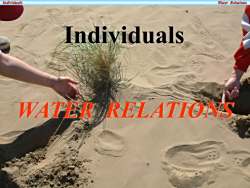
IndividualsWater RelationsIndividualsWATERRELATIONSX
Individuals Water Relations WATER RELATIONS Individuals
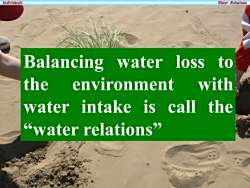
IndividualsWater RelationsBalancinglosswatertothewithenvironmentintake is callthewater"water relations
Individuals Water Relations Balancing water loss to the environment with water intake is call the “water relations
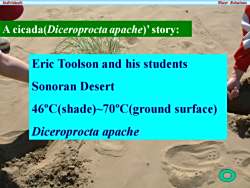
IndividualsWater RelationsA cicada(Diceroproctaapache)'story:Eric Toolson and his studentsSonoran Desert46°C(shade)~70°C(ground surface)Diceroprocta apache福
Individuals Water Relations A cicada(Diceroprocta apache)’ story: Eric Toolson and his students Sonoran Desert 46ºC(shade)~70ºC(ground surface) Diceroprocta apache
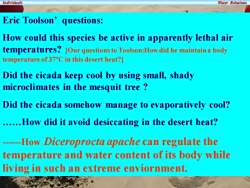
IndividualsWaterRelationsEric Toolson' questions:How could this species be active in apparently lethal airtemperatures?[Our questionsto Toolson:Howdid he maintaina bodytemperatureof37°Cinthis desertheat?Did the cicada keep cool by using small, shadymicroclimates in the mesquit tree?Did the cicada somehow manage to evaporatively cool?..How did it avoid desiccating in the desert heat?-HowDiceroproctaapachecan regulatethetemperature and water content of its body whilelivingin such an extreme enviornment
Individuals Water Relations Eric Toolson’ questions: How could this species be active in apparently lethal air temperatures? [Our questions to Toolson:How did he maintain a body temperature of 37ºC in this desert heat?] Did the cicada keep cool by using small, shady microclimates in the mesquit tree ? Did the cicada somehow manage to evaporatively cool? .How did it avoid desiccating in the desert heat? -How Diceroprocta apache can regulate the temperature and water content of its body while living in such an extreme enviornment
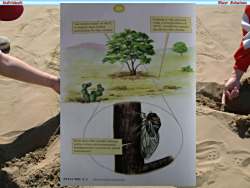
IndividualsWater RelationsFallingtothegroundwithatemperatureofAirtemperunreora6ec70°c wouldbe certainishigherthanlethaldeath tor the cicadnmaximumrorthecicadaHow does the cicada remainactixewhenenviroumentultemperatures exceedits lethalmaxmumn?FIGURE5.1Aneeologicalpztle
Individuals Water Relations
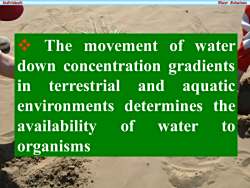
IndividualsWater RelationsXTheof watermovementdown concentration gradientsinandterrestrialaquatictheenvironmentsdeterminesoftoavailabilitywaterorganisms
Individuals Water Relations ❖ The movement of water down concentration gradients in terrestrial and aquatic environments determines the availability of water to organisms

IndividualsWater RelationsWater Content of Air
Individuals Water Relations ➢ Water Content of Air
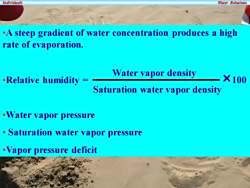
IndividualsWater RelationsA steep gradient of water concentration produces a highrateof evaporationWater vapor densityX100RelativehumiditySaturation watervapor densityWatervaporpressureSaturation watervaporpressuredeficit.Vaporpressure
Individuals Water Relations •A steep gradient of water concentration produces a high rate of evaporation. •Relative humidity = 100 •Water vapor pressure • Saturation water vapor pressure •Vapor pressure deficit Water vapor density Saturation water vapor density
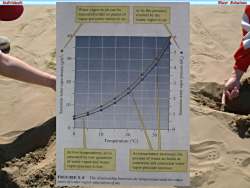
IndividualsWater RelationsWatervapor in aircan beorbythepressuremeasured eitheras grams ofexertedbythevaporpercubicmeterofairwatervaporinair40D5nsoo3020210--00102030Temperature (C)Arlowtemperatures,airisAstemperatureincreases,thesaturated by low quantitiesamountofwaterairholdsatofwatervaporand watersaturation and saturation watervaporpressure is low.vaporpressureincreaseFIGURE5.2The relationshipbenwveenair temperature and rwo mea-suresofwatervaporsaturationofair
Individuals Water Relations

IndiidualsWater RelationsThevaporpressuredeficit(ypd)indicatesthe gradientinwaterconcentration from aterrestrial organismto theairA highervpd indicatesa steeperconcentrationgradient.AhighvpdindicatesthattheAlowvpdindicatesthatthewatervaporcontentofairiswatervaporcontentofairiswellbelowsaturation.near saturation,EvaporationEvaporationWhere the vpd ishigh,theWherethevpd is low.therate of evaporative waterrate of evaporative waterlossbyorganisms is higher.lossbyorganismsis lower.FIGUREVaporpresuredefiandevaporativewaerlossbyrresrialoganism
Individuals Water Relations
按次数下载不扣除下载券;
注册用户24小时内重复下载只扣除一次;
顺序:VIP每日次数-->可用次数-->下载券;
- 《生态学》课程PPT教学课件(生态学原理与应用)03 Individuals - energy and nutrient relations.ppt
- 《生态学》课程PPT教学课件(生态学原理与应用)04 population Distribution and abundance.ppt
- 《生态学》课程教学资源(PPT课件)生态环境建设与生态工程技术的应用(石河子大学:王绍明).ppt
- 《生态学》课程PPT教学课件(生态学原理与应用)04 population Growth.ppt
- 《生态学》课程PPT教学课件(生态学原理与应用)05 interactions Competition.ppt
- 《生态学》课程PPT教学课件(生态学原理与应用)05 interactions Exploitation.ppt
- 《生态学》课程PPT教学课件(生态学原理与应用)06 Large-scale ecology Geographic ecology.ppt
- 《生态学》课程PPT教学课件(生态学原理与应用)05 interactions Mutualism.ppt
- 《生态学》课程教学资源(PPT课件)第六章 生态系统生态学 Ecosystem Ecology.ppt
- 《生态学》课程教学资源(PPT课件)第七章 景观生态学.ppt
- 《生态学》课程教学资源(PPT课件)第三章 保护生物学——生物多样性的价值.ppt
- 《生态学》课程教学资源(PPT课件)第三章 地球生命的起源与进化——进化的历程.ppt
- 《生态学》课程教学资源(PPT课件)第一章 保护生物学的定义.ppt
- 《生态学》课程教学资源(PPT课件)有机体与环境(第三章 物质环境).ppt
- 《生态学》课程教学资源(PPT课件)有机体与环境(第二章 能量环境 2/2).ppt
- 《生态学》课程教学资源(PPT课件)普通生态学 General Ecology - 绪言.ppt
- 《生态学》课程教学资源(PPT课件)有机体与环境(第1章 生物与环境、第二章 能量环境 1/2).ppt
- 《生态学》课程教学资源(PPT课件)种群生态学(第四章 种群及其基本特征2/2).ppt
- 《生态学》课程教学资源(PPT课件)有机体与环境(第三章 物质环境).ppt
- 《生态学》课程教学资源(PPT课件)种群生态学(生物入侵——新世纪的生态学挑战).ppt
- 《生态学》课程PPT教学课件(生态学原理与应用)03 Individuals -1/2 Temperature.ppt
- 《生态学》课程PPT教学课件(生态学原理与应用)04 population Dynamics.ppt
- 《生态学》课程PPT教学课件(生态学原理与应用)02 Natural History - 2/2.ppt
- 《生态学》课程PPT教学课件(生态学原理与应用)01 what is ecology.ppt
- 《生态学》课程PPT教学课件(生态学原理与应用)02 Natural History - 1/2.ppt
- 《环境工程原理》课程教学大纲 Principles of Environmental Engineering.doc
- 《环境工程原理》课程授课教案(讲稿)第09章 吸附.pdf
- 《环境工程原理》课程授课教案(讲稿)第10章 其它分离过程.pdf
- 《环境工程原理》课程授课教案(讲稿)第07章 过滤.pdf
- 《环境工程原理》课程授课教案(讲稿)第08章 吸收.pdf
- 《环境工程原理》课程授课教案(讲稿)第05章 质量传递.pdf
- 《环境工程原理》课程授课教案(讲稿)第06章 沉降.pdf
- 《环境工程原理》课程授课教案(讲稿)第03章 流体流动.pdf
- 《环境工程原理》课程授课教案(讲稿)第04章 热量传递.pdf
- 《环境工程原理》课程授课教案(讲稿)第01章 绪论.pdf
- 《环境工程原理》课程授课教案(讲稿)第02章 质量衡算与能量衡算.pdf
- 《环境工程原理》课程实验教学大纲 Principles of Environmental Engineering.doc
- 《环境工程原理》课程作业习题(含解答)第09章 吸附.pdf
- 《环境工程原理》课程作业习题(含解答)第10章 其他分离过程.pdf
- 《环境工程原理》课程作业习题(含解答)第08章 吸收.pdf
